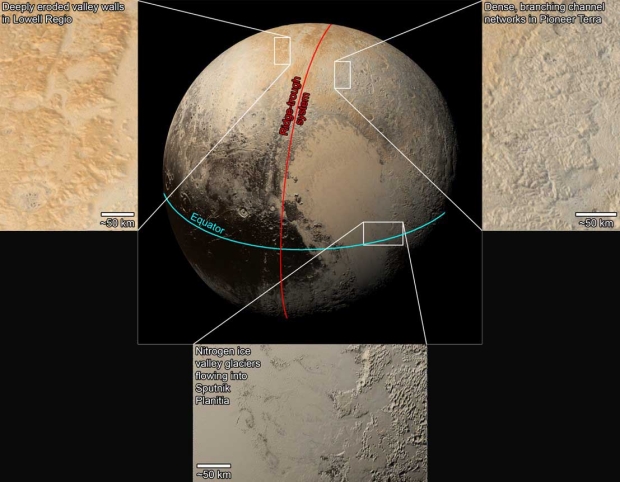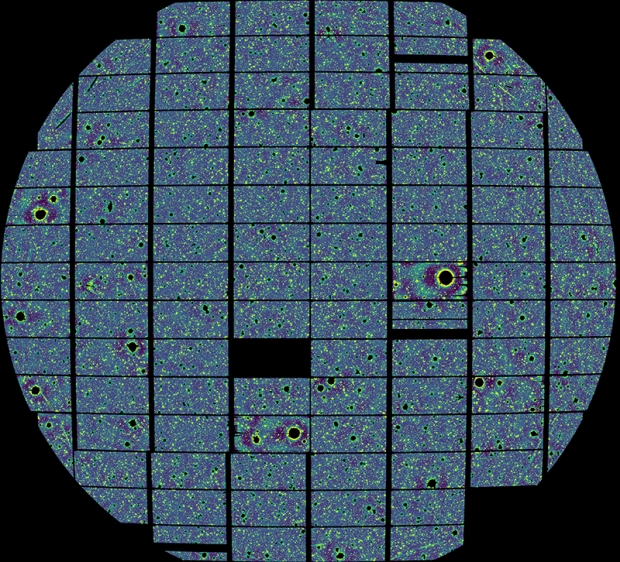New Horizons is, like the two Voyagers, a gift that keeps on giving, even as it moves through the Kuiper Belt in year 17 of its mission. Thus the presentations that members of the spacecraft team made on March 14 at the 54th Lunar and Planetary Science Conference. Papers will flow out of these observations, including interpretations of the twelve mounds on the larger lobe of Arrokoth, the contact binary that is being intensely studied through stereo imaging to identify how these features formed around a larger center mound. Alan Stern (SwRI) is principal investigator for the New Horizons mission:
“We discovered that the mounds are similar in many respects, including their sizes, reflectivities and colors. We believe the mounds were likely individual components that existed before the assembly of Arrokoth, indicating that like-sized bodies were formed as precursors to Arrokoth itself. This is surprising, and a new piece in the puzzle of how planetesimals – building blocks of the planets, like Arrokoth and other Kuiper Belt objects come together.”
Science team members also discussed the so-called ‘bladed terrain,’ evidently the product of methane ice, that seems to stretch across large areas of Pluto’s ‘far side,’ as observed during the spacecraft’s approach. It was intriguing to learn as well about the spacecraft’s observations of Uranus and Neptune, which will complement Voyager imaging at different geometries and longer wavelengths. And Pluto’s ‘true polar wander’ (the tilt of a planet with respect to its spin axis came into play (and yes, I do realize I’ve just referred to Pluto as a ‘planet’). Co-investigator Oliver White:
“We’re seeing signs of ancient landscapes that formed in places and in ways we can’t really explain in Pluto’s current orientation. We suggest the possibility is that they formed when Pluto was oriented differently in its early history, and were then moved to their current location by true polar wander.”

Image: Pluto’s Sputnik Planitia, the huge impact basin found in Pluto’s ‘heart’ region, seems to have much to do with the world’s axial tilt, while the possibility of a deep ocean pushing against the basin from below has to be taken into account. This image is from the presentation by Oliver White (SETI Institute) at LPSC. Credit: NASA/Johns Hopkins APL/SwRI/James Tuttle Keane.
But let me pause today on the quest for other Kuiper Belt Objects as the search for a second flyby candidate continues. Not that a flyby is essential. Using the Japanese Subaru Telescope in Hawaii and the Victor M. Blanco instrument at Cerro Tololo, the team is now applying a deep learning algorithm (a ‘convolutional neural network’) to analyze imagery. Wes Fraser, a member of the science team, is quoted on the New Horizons site as saying “The software network’s classification performance is extremely good, significantly cutting back on ‘false’ candidate sources. An entire night’s worth of search data requires only a few hours of human vetting. Compare that to the weeks it used to take to do this!”

Image: A “stack” of images from one night of observing with the Subaru Telescope’s Hyper Suprime-Cam, showing myriad stars that illustrate the difficulty of spotting an undiscovered Kuiper Belt object. The animation below shows movement – across the center-right of the frame — of a newly discovered KBO in one of these images. Credit: NASA/Johns Hopkins APL/Southwest Research Institute/Subaru Telescope.
The point is that we’re learning a great deal about KBOs even in the absence of another flyby, discovering a surprising number of objects like that shown (look carefully) in the animation below. The Subaru Telescope produced, with its wide field of view, some 87 new KBOs in 2020 in the direction of the spacecraft’s trajectory. It was heartening to learn that running that same data through the new software enabled a search that was both 100 times faster but also revealed another 67 KBOs. Some of these – and about 20 will be close enough to observe from a distance of millions of miles – should be grist for the mill as New Horizons examines them in the coming two years.
Image: This animation shows movement—across the center-right of the frame—of a newly discovered Kuiper Belt object in one of the Subaru Telescope Hyper Suprime-Cam images. Credit: NASA/Johns Hopkins APL/Southwest Research Institute/Subaru Telescope.
Will JHU/APL’s Interstellar Probe design eventually be approved and join the spacecraft now departing our Solar System? Or will JPL’s Solar Gravity Lens mission to the gravitational focus become our next deep space sojourner? As we ponder mission designs and the likelihood of their approval, keeping an eye on our existing assets in deep space reminds us of the outstanding science return we’ve achieved thus far.



Looking at the animation that shows the KBO, I have to wonder why a DNN was needed to identify the KBO. Was it to post-process the data of the movement to eliminate artifacts? The movement could be detected by frame analysis of the light sources (serial blinks) and would not need anything like an ML approach to extract the moving light source (and how would it be trained?)
Elsewhere I have read that funding almost requires some use of AI, and I wonder if this might be the case here. Is there any info on how it was used to find and qualify KBOs from the images?
I assume an upcoming paper will give us the details, though I have no information yet on when it might be published.
I see the little wanderer. Any ideas about how big this object is?
It’s obvious in that clip because it’s been found and a video compiled, It’s not nearly so easy to find when you are just handed the raw data.
It’s a planet, but not a PLANET planet.
It’s dwarfed by other planets…
Like everyone here, I guess, I’ve read about how it was astronomers who changed their technical definition (at an underattended session on the last day of a conference, above many objections), and planetary scientists — who would otherwise have been tempted to ignore what the astronomers decided — were taken aback at how it was picked up so fervently by mass media and school-age educational materials. I got the impression at first that planetary scientists would continue using their own definition, the astronomers and the publicity hype around their definition change notwithstanding. Have they now conformed to the astronomers’ decision or does that community hold out still with a more permissive category of planet?
Video lecture on a global geological map of Pluto…
https://m.youtube.com/watch?v=qqve8iNb7O0
Very good video about Pluto’s geology. An interesting suggestion about polar wanted probably after the impact at Sputnik.
Hi Paul
A really good post, your right even if no flybys happen identifying these objects is still good science.
I have also sent two interesting papers to your inbox as well tonight activity on Venus and a look at a nearby brown dwarf/planet.
Cheers Edwin
Thanks, Edwin. Always glad to hear from my friends in New Zealand.
“The Twelve Mounds of Arrokoth,” sounds like a title from a 1940s science fiction novel.
Indeed! Sounds like a late ’40s issue of Planet Stories to me.
I’ve been looking at what we would be running into as our solar system merry-go-round is flying through the dense arms of the galaxy. We are moving at 20 miles per second or about 72,000 Mph or Mach 94 faster then the arms. The northern hemisphere is facing the onslaught as we spin around the sun. What would happen if we impacted a rogue dwarf water world like Pluto? Pluto has about a much water as in the oceans of earth so how would the rest of the volatile elements interreact and would we see traces of those elements in ancient zircon crystal. Could the early oxygen levels and other elements be from a liquid ball hitting the earth.
Solar System’s largest ocean worlds compare in size.
https://i.insider.com/57fbf1634046ddf8008b4c87?width=2500&format=jpeg&auto=webp
Science is always conservative when learning about new concepts or exploring new realms. The best way to learn may be via taking an opposite perspective from the normal view. We view the solar system as being ancient and stable over long periods and that is most likely true for the large bodies that exist here. When we start looking at the smaller bodies that may not be true, we see a huge number of small satellites around the planets and dwarf planets out beyond the asteroid belt. Could a large percentage of these objects be rogue bodies that have been captured when we pass through the milky way arms? May the large number of comets in the Oort cloud not be from the original cloud that formed the solar system or the nearby passage of other stars but from the Sun’s passage through the dense clouds full of icy bodies in the milky ways arms? These objects may be what has brought earth water when other events may have turned the earth into deserts. These smaller dwarfs in the 100 to 800 mile range are almost 100 percent ice with the majority being water. I have created an AI enlargement of the image about the sun’s movement through the galaxy and the extinction events and impacts that have occured during it passage. What is interesting is our movement since the Chicxulub crater happened 66 million years ago is through a region of open space between arms. We are entering the Orion-Cygnus Arm or Orion Spur which may of been the cause of the Younger Dryas impacts at the end of the last Ice age. This spur is also the location of Yarrabubba impact 2.229 billion years ago that ended the 300 million year Huronian glaciation.
https://pbs.twimg.com/media/Frl8_1makAAWGB3?format=jpg&name=4096×4096
Everybody who read that article thought about doing that … glad someone did it! How strange it is to speculate that the Cosmos might have ordained the same pace of mass extinctions on most of the planets of this galaxy, and beyond?